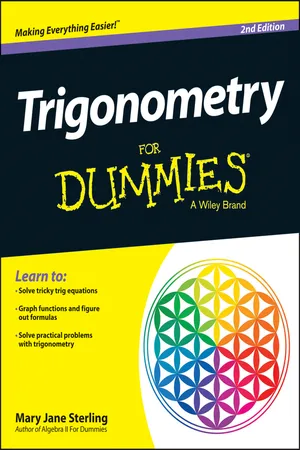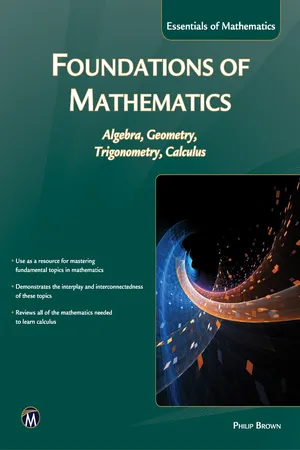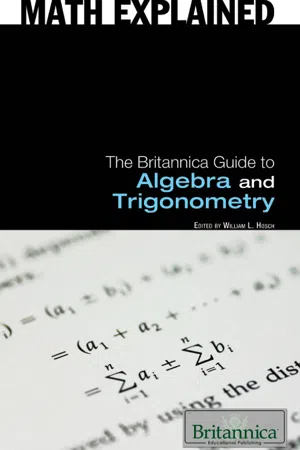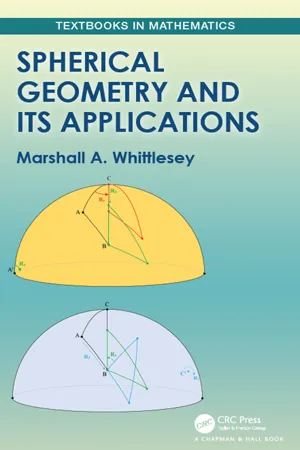Mathematics
Pythagorean Identities
Pythagorean identities are a set of trigonometric equations that relate the three basic trigonometric functions: sine, cosine, and tangent, with the Pythagorean theorem. These identities are used to simplify trigonometric expressions and solve trigonometric equations.
Written by Perlego with AI-assistance
Related key terms
Related key terms
1 of 4
Related key terms
1 of 3
6 Key excerpts on "Pythagorean Identities"
- eBook - ePub
- Boris Pritsker(Author)
- 2019(Publication Date)
- Dover Publications(Publisher)
Chapter 6 Trigonometric Identities Trigonometric identities in problem solvingGreek words trigonon —“triangle” and metron —“measure” form the name “trigonometry,” one of the branches of mathematics, which historically originated from applications of geometry to astronomical calculations and studies. The ancient Greek mathematician and astronomer Hipparchus of Nicaea (c. 190–c. 120 BC) is regarded as the father of trigonometry. He was credited with the calculation and construction of the first trigonometric tables used in various astronomical computations. Starting from the studies of relationships involving lengths of the sides and angle measures in right triangles, mostly utilized in astronomy and navigation during ancient times, trigonometry eventually grew into a separate branch of mathematics. It is involved in various calculations and applications, not just in pure mathematics, but in such fields as physics, land surveying and geodesy, engineering, astronomy, music theory, acoustics, optics, chemistry, cryptology, architecture, computer graphics, meteorology, biology, and even ecology. The list can be endless, as it is hard to imagine any scientific research not utilizing trigonometric applications in one way or another.There is a common perception though among high school students about trigonometric functions as being used in geometry only to relate the angles of a triangle to its sides. For many their application of those functions is restricted to the calculation of the elements of a right triangle. There is not much time devoted to the study of trigonometric functions and trigonometric equations in the high school curriculum. In this and the next chapter we will try to fill that hole to some degree and offer an insight into the application of trigonometric functions in algebra, demonstrate various techniques for solving trigonometric equations, and give their connections to other topics covered throughout the book. - No longer available |Learn more
- Mary Jane Sterling(Author)
- 2014(Publication Date)
- For Dummies(Publisher)
One special case of working on both sides of an identity at the same time is to square both sides. Your biggest clue as to when to use this technique is usually when one side or the other has a radical. This method is also good to use when you're solving some types of trig equations. Squaring both sides has two benefits: It gets rid of radicals, and it often creates terms that can be part of one of the Pythagorean Identities. The Pythagorean Identities have wonderful substitutions.This first example has only one radical, and it's on the right side. Solve the identity .- Square both sides of the identity.
Be sure to expand the squared binomial on the left correctly.
- Rearrange the terms in the numerator.
- Replace 1 + cot2xwith its equivalent by using the Pythagorean identity.
- Split up the fraction by writing each term in the numerator over the denominator.
- Simplify the first term. Rewrite the numerator and denominator in the second term by using the ratio and reciprocal identities.
- Simplify the complex fraction by flipping the denominator and multiplying it by the numerator.
Identifying With the Operations
Identities that have sums, differences, multiple angles, and half-angles have a suggested procedure just staring at you, because having all the functions in terms of the same angle — not twice one or the sum of the other two — is best. You just decide which angle form you want everything to be in and then apply whatever identity the terms in the equation are equal to — substitute in the equivalence of the identity — and proceed from there.Adding it up
Sum and difference identities usually involve two different angles and then a third combined angle. To prove the identity, you need to get rid of that third angle. The first example involves a sum of two different angles.The equation uses the angles x and y . Get rid of the angle sum, x + y , by applying the appropriate identity, which contains just angle x and angle y .- Replace the cosine of the sum of the two angles with its identity.
- Break up the fraction by putting each term in the numerator over the denominator.
- Reduce the first fraction. Rewrite the second fraction as the product of two fractions. Then replace the two fractions in that product by using the ratio identity.
- eBook - ePub
Foundations of Mathematics
Algebra, Geometry, Trigonometry and Calculus
- Philip Brown(Author)
- 2016(Publication Date)
- Mercury Learning and Information(Publisher)
2 and the same for other trigonometric ratios. Thus, another way to write the equation for the unit circle isThis is a restatement of the Pythagorean Theorem if θ is an angle in the first quadrant, and a = cos(θ) and b = sin(θ) are regarded as the lengths of the short sides of a right triangle with a hypotenuse of length 1. If we divide both sides of formula (4.4) by cos2 θ, distribute the denominator on the left-hand side, and rewrite the resulting terms by making use of the reciprocal trigonometric ratios, then formula (4.4) becomesIn the same way, by dividing both sides of formula (4.4) by sin2 (θ), we deriveStrictly speaking, the second and third Pythagorean Identities have been derived only for values of θ for which the terms are defined. In the case of the second Pythagorean identity, for instance, the terms tan2 θ and sec2 θ not defined if θ is an integer multiple ofIn trigonometry, we use known identities to prove or verify more identities. The usual technique for doing this is to denote the left-hand side of the unproven identity as LHS and the right-hand side as RHS. One of the sides, either LHS or RHS, is then restated and manipulated by means of known identities and algebraic methods until it is shown to be equivalent to the other side. Alternatively, both sides can be restated and manipulated until it can be shown that they are both equivalent to some (new) expression. In the following example, each line is a restatement of the previous line by the means explained to the right of each line.EXAMPLE 4.9.1. Verify the identity: tan(θ) + cot(θ) = sec2 (θ)cot(θ).Answer:The next example is an application of FOIL (see section 1.8.1 ).EXAMPLE - eBook - ePub
- Britannica Educational Publishing, William Hosch(Authors)
- 2010(Publication Date)
- Britannica Educational Publishing(Publisher)
A .Of fundamental importance for the study of trigonometry are the addition formulas, functions of the sum or difference of two angles. From the addition formulas are derived the double-angle and half-angle formulas. Numerous identities of lesser importance can be derived from the above basic identities.TABLES OF NATURAL FUNCTIONSTo be of practical use, the values of the trigonometric functions must be readily available for any given angle. Various trigonometric identities show that the values of the functions for all angles can readily be found from the values for angles from 0° to 45°. For this reason, it is sufficient to list in a table the values of sine, cosine, and tangent for all angles from 0° to 45° that are integral multiples of some convenient unit (commonly 1′). Before computers rendered them obsolete in the late 20th century, such trigonometry tables were helpful to astronomers, surveyors, and engineers.For angles that are not integral multiples of the unit, the values of the functions may be interpolated. Because the values of the functions are in general irrational numbers, they are entered in the table as decimals, rounded off at some convenient place. For most purposes, four or five decimal places are sufficient, and tables of this accuracy are common. Simple geometrical facts alone, however, suffice to determine the values of the trigonometric functions for the angles 0°, 30°, 45°, 60°, and 90°.PLANE TRIGONOMETRYIn many applications of trigonometry, the essential problem is the solution of triangles. If enough sides and angles are known, the remaining sides and angles as well as the area can be calculated, and the triangle is then said to be solved. Triangles can be solved by the law of sines and the law of cosines. To secure symmetry in the writing of these laws, the angles of the triangle are lettered A, B , and C and the lengths of the sides opposite the angles are lettered a, b , and c - eBook - ePub
- (Author)
- 2008(Publication Date)
- Trade Paper Press(Publisher)
Trigonometry solves problems relating to plane and spherical triangles. Its principles are based on the fixed proportions of sides for a particular angle in a right-angled triangle, the simplest of which are known as the sine, cosine, and tangent (so-called trigonometrical ratios). Trigonometry is of practical importance in navigation, surveying, and simple harmonic motion in physics.trigonometry At its simplest level, trigonometry deals with the relationships between the sides and angles of triangles. Unknown angles or lengths are calculated by using trigonometrical ratios such as sine, cosine, and tangent.Using trigonometry, it is possible to calculate the lengths of the sides and the sizes of the angles of a right-angled triangle as long as one angle and the length of one side are known, or the lengths of two sides. The longest side, which is always opposite to the right angle, is called the hypotenuse . The other sides are named depending on their position relating to the angle that is to be found or used: the side opposite this angle is always termed opposite and that adjacent is the adjacent . So the following trigonometrical ratios are used:sine
The sine is the function of an angle in a right-angled triangle which is defined as the ratio of the length of the side opposite the angle to the length of the hypotenuse (the longest side). It is usually shortened to sin .sine The sine is a function of an angle in a right-angled triangle found by dividing the length of the side opposite the angle by the length of the hypotenuse (the longest side). Sine (usually abbreviated sin) is one of the fundamental trigonometric ratios.Various properties in physics vary sinusoidally; that is, they can be represented diagrammatically by a sine wave (a graph obtained by plotting values of angles against the values of their sines). Examples include simple harmonic motion, such as the way alternating current (AC) electricity varies with time.sine (left) The sine of an angle; (right) constructing a sine wave. The sine of an angle is a function used in the mathematical study of the triangle. If the sine of angle β is known, then the hypotenuse can be found given the length of the opposite side, or the opposite side can be found from the hypotenuse. Within a circle of unit radius (left), the height P1 ,A1 equals the sine of angle P1 0A1 - eBook - ePub
- Marshall Whittlesey(Author)
- 2019(Publication Date)
- Chapman and Hall/CRC(Publisher)
Chapter 4Trigonometry
15 Spherical Pythagorean theorem and law of sines
Spherical trigonometry is the key to the study of the precise relationship among distances and angles on the sphere. Central to this is the relationship among the distances and angles in a triangle. But what makes these relationships different from the corresponding relationships in the plane?The central geometric difference between the plane and the sphere is, of course, the fact that the sphere is “curved.” In the plane, if we take two rays with the same endpoint, then the rays separate away from the common endpoint. On the sphere, two such rays separate for a while away from the endpoint but then converge back together at the antipode of the endpoint. We first quantify this behavior of rays on the sphere with a proposition.Proposition 15.1 (A-12) Suppose two rays form an angle with measure θ. Let x be the spherical distance between two points (one on each ray) at spherical distance ϕ from the vertex. Then sin(x 2) = sin(ϕ)sin(θ 2).We have seen this proposition already: it is Proposition 6.1 of §6. (See also Figure 2.8.) There we proved it as a theorem for spheres in space, using the properties of three-dimensional geometry. In our axiomatic system we do not have those techniques available and we will assume it as an axiom. However, this is not strictly necessary: if we assume certain properties of trigonometric functions and certain properties of the real numbers from real analysis, we can prove Proposition 15.1 as a theorem. This is sufficiently difficult that it is beyond the scope of this book. However, we refer the interested reader to [Ca1916], p. 136 , or [Wo1945], to see how this can be done.1We use this result to determine properties of right triangles on the sphere. We adopt the following notation. In a triangle ΔsABC, let A, B, and C denote the measures of the angles at vertices A, B, and C, respectively, and let a, b, and c denote the lengths of the sides opposite vertices A, B, and C, respectively. This means that the letters A, B, and C
Index pages curate the most relevant extracts from our library of academic textbooks. They’ve been created using an in-house natural language model (NLM), each adding context and meaning to key research topics.
Explore more topic indexes
Explore more topic indexes
1 of 6
Explore more topic indexes
1 of 4





